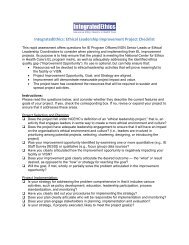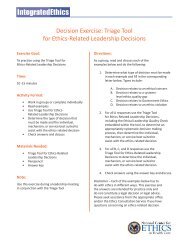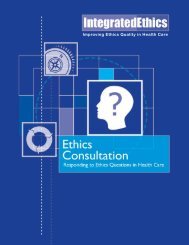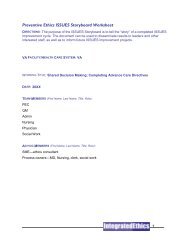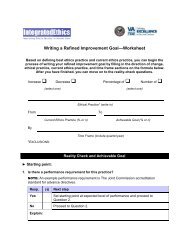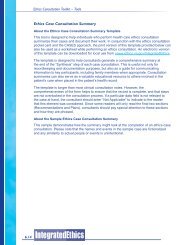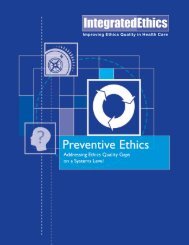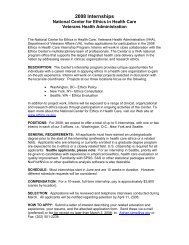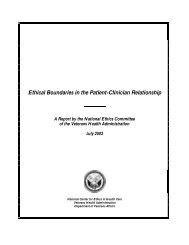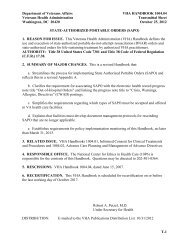Ethical Leadership: Fostering an Ethical Environment & Culture ...
Ethical Leadership: Fostering an Ethical Environment & Culture ...
Ethical Leadership: Fostering an Ethical Environment & Culture ...
Create successful ePaper yourself
Turn your PDF publications into a flip-book with our unique Google optimized e-Paper software.
Part II: Introduction to <strong>Ethical</strong> <strong>Leadership</strong>• When nearly everyone in <strong>an</strong> org<strong>an</strong>ization seeks consultation about ethicalconcerns when needed, vexing concerns c<strong>an</strong> be effectively resolved. When theethics consultation service is accessible <strong>an</strong>d helpful, staff, patients, <strong>an</strong>d familiesknow that their concerns will be taken seriously <strong>an</strong>d addressed. When org<strong>an</strong>izationsdon’t have <strong>an</strong> internal mech<strong>an</strong>ism for resolving ethical concerns, individuals may feelfrustrated, helpless, unsupported, or even compelled to take their concerns outsidethe org<strong>an</strong>ization, for example, to Congress or the media. Not only does effectiveethics consultation improve satisfaction for patients, families, <strong>an</strong>d staff; it also c<strong>an</strong>help to reduce utilization of wasteful or unw<strong>an</strong>ted treatments.[9,12] For example, onerecent multicenter study showed that ethics consultations were not only viewed ashelpful by the great majority of requesters, but also reduced hospital days <strong>an</strong>d useof nonbeneficial life-sustaining treatments among dying patients.[9]• When nearly everyone in <strong>an</strong> org<strong>an</strong>ization works to resolve ethics issues ona systems level, staff members at all levels apply systems thinking to addressongoing org<strong>an</strong>izational systems <strong>an</strong>d processes that give rise to ethical uncertaintyor conflict. When org<strong>an</strong>izations encourage systematic approaches to ethics issues,employees seek “upstream” solutions to keep the “downstream” problems fromarising. They’re attentive to ethics quality gaps between the org<strong>an</strong>ization’s currentpractices <strong>an</strong>d best practices <strong>an</strong>d seek ways to reduce those gaps.• When nearly everyone in <strong>an</strong> org<strong>an</strong>ization sees ethics as part of quality, staffmembers recognize that ethics is just as essential to health care quality as technicalcompetence <strong>an</strong>d customer service.[20] They also recognize that problems c<strong>an</strong>surface either as quality issues or as ethics issues—<strong>an</strong>d that quality issues oftenimplicate ethics issues <strong>an</strong>d vice versa. In a strong ethical environment, leadersensure that perform<strong>an</strong>ce measures include expectations for ethical practice <strong>an</strong>d thatthe org<strong>an</strong>ization’s system of incentives <strong>an</strong>d rewards are aligned with its mission <strong>an</strong>dvalues.• When nearly everyone in <strong>an</strong> org<strong>an</strong>ization underst<strong>an</strong>ds what’s expected of himor her with respect to ethical practice, it’s easier for staff to know <strong>an</strong>d do the rightthing. Employees underst<strong>an</strong>d that leaders expect high ethics quality, w<strong>an</strong>t to knowabout ethical problems in the org<strong>an</strong>ization, <strong>an</strong>d hold everyone to the same (explicit)st<strong>an</strong>dards. Individuals don’t find themselves in ambiguous, ill-defined situationsthat c<strong>an</strong> lead to misjudgment or mism<strong>an</strong>agement. Empirical evidence indicates thatcorporate sc<strong>an</strong>dal <strong>an</strong>d misconduct are more likely if leaders foster <strong>an</strong> environmentin which things are left unsaid: Employees c<strong>an</strong> interpret the silence to indicatethat there are things leaders don’t w<strong>an</strong>t to know about, or even tacitly approve.[19]If leaders send mixed signals about their expectations for ethical practice—forexample, by saying one thing but implying <strong>an</strong>other through their actions—employeesare likely to misinterpret what they are being asked to do. Making expectations clearprovides the guid<strong>an</strong>ce employees need to do the right thing.• When nearly everyone in <strong>an</strong> org<strong>an</strong>ization feels empowered to behave ethically,staff members are confident they’ll be supported when they do the right thing. Whenemployees feel that they c<strong>an</strong>’t do what they know is right or they perceive thatethical practice isn’t rewarded while unethical practice is acceptable (or evenrewarded), they often experience moral distress, a major cause of employeeburnout.[13] When the org<strong>an</strong>ization dem<strong>an</strong>ds unquestioning obedience to authority<strong>an</strong>d discourages employees from voicing ethical concerns, ethical behavior is15



